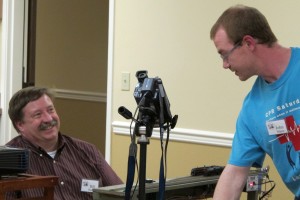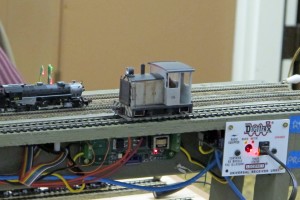Al Carter / Photos by Al Frasch
Chairman Rich Blake started the meeting and welcomed 38 eager attendees to the April 2013 Clinic. Al Carter reported on the upcoming Fourth Division Spring Meet to be held on May 17-18 in Tukwila and on the June 26-30 Pacific Northwest Region meet to be held in Boise, Idaho. Susan Gonzales discussed several of the clinics scheduled for the 2013-2014 season, including a field trip to the Mount Rainier Scenic Railway, in late September.
One new attendee showed up, John Fuik of Anacortes, along with his wife Marjorie. For the Tool of the Month, Al Carter showed off MicroMark’s “Thin Beam” square, an invaluable tool for scribing sheet styrene and wood. John Mann displayed another MicroMark product – the “Crocodile Action Ear Polypus,” which is a nifty forceps-type tool that can fit into a 1/8” diameter hole.
Another member (sorry but I didn’t catch the name) reported on the fact that anyone with a Sno-Isl library card can subscribe to Model Railroader and also to Fine Scale Modeler, thus saving the yearly subscription costs. However, back issues are only available for the current year via the library. And apparently, anyone with a valid library card in the state of Washington can use this system. For further details, click here.
The “Main Event” of the evening was a clinic on installing sound decoders, by John Mann and Bill Harper. John started off by explaining that in our modeling world, size can be compressed to whatever size or scale we want, but sound is a different matter – think of muting the sound, rather than compressing it. There are lots of manufacturers of sound decoders available now and some sound a lot better than others. Prices generally reflect this, of course. ohn demonstrated this difference by letting us hear Digitrax (lower end) and Tsunami (higher end) decoders.
John brought an incredible array of materials and supplies to augment his program, including a lot of hardware in addition to the actual decoders, including speaker enclosures, axle and drive wheel wipers, chuff sync devices, very fine and flexible wire, and mini-connectors. He pointed out that while most of the DCC manufacturers offer much of this equipment, one can also go to non-railroad supply houses such as Allied Electronics, Digikey, etc.
John and Bill described how adding a capacitor to the decoder circuit allows the sound to keep on uninterrupted, despite the locomotive running over dirty track or other disturbances in the signal reaching the decoder. We learned a lot about capacitors, including different types and ratings.
Here’s a great tip, not only for sound decoder installation, but actually any modeling you do: take digital photographs of your work and your finished product for later reference.
John finished the evening with a great demonstration of several different sized speakers, both with and without speaker enclosures. It is truly amazing how a proper speaker enclosure enhances the sound. We learned a lot from John and Bill last night!



No Comments Yet